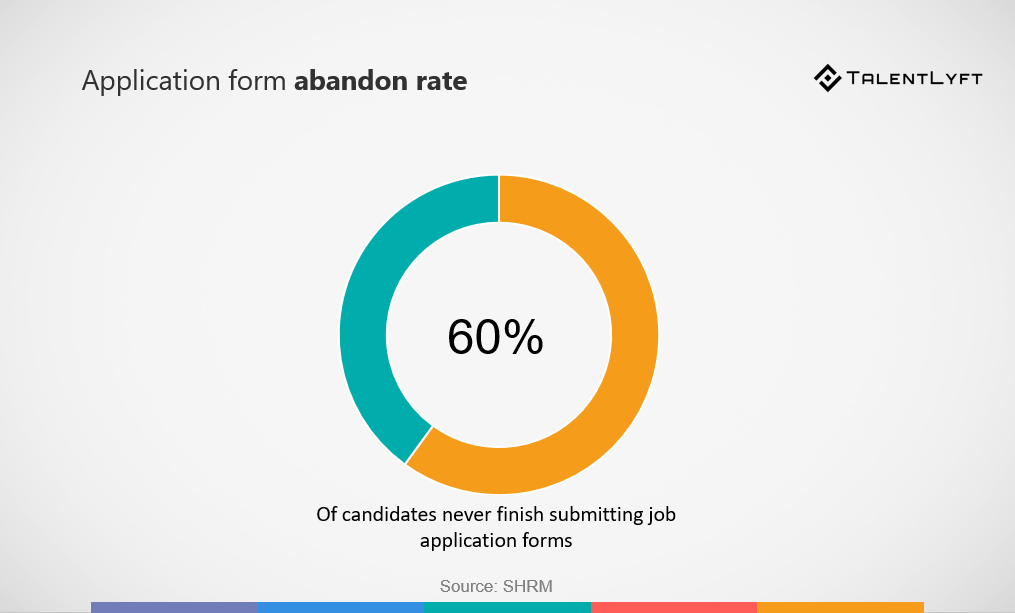What is Abandon rate?
Abandon rate is one of the most important HR metrics. They show HR professionals how optimized and user-friendly their job application forms and process are.
Abandon rate definition
In the context of human resources (HR), abandon rate is a metric that refers to the rate at which job applicants or candidates withdraw or abandon the application process before its completion. It represents the percentage of individuals who start an application but do not finish it, either by not submitting it or by dropping out at some point during the process.
How to measure abandon rate
To calculate the abandon rate, take the number of all people that apply for job openings, divide it by the total number of all people that start filling out the form, and multiply the result by 100 to get a percentage.
Why is the application form abandon rate important?
The abandon rate is an important metric for HR departments as it provides insights into the effectiveness and efficiency of the recruitment process. A high abandon rate could indicate potential issues with the application process itself, such as excessive length, complexity, or technical difficulties. It may also suggest a lack of engagement or interest from candidates due to various reasons, such as a poor candidate experience or unattractive job offerings.
It shows you how interesting your career site is, and how user-friendly your application form is. In addition, shorter, user-friendly job application forms are much more likely to improve candidate experience.
Research says that over 60% of people that start applying, never finish the form.

How to improve the rate
By monitoring and analyzing the application form abandon rate, you can identify bottlenecks or areas for improvement in your recruitment process. You can then take steps to streamline the application process, enhance candidate engagement, and address any underlying concerns that may be causing candidates to abandon their applications.Here are some strategies you can consider:
- Simplify the application process: Streamline the application process by minimizing the number of steps and reducing unnecessary or repetitive information requests. Make sure the application form is user-friendly and easy to navigate.
- Optimize the application for mobile devices: With an increasing number of candidates using smartphones and tablets to apply for jobs, it's essential to ensure that your application process is mobile-friendly and compatible with different screen sizes.
- Enhance user experience: Focus on creating a positive candidate experience throughout the application process. Provide clear instructions, use intuitive design elements, and offer progress indicators to help candidates understand where they are in the process.
- Provide realistic job previews: Clearly communicate the job requirements, responsibilities, and expectations to candidates. Offering realistic job previews can help candidates self-assess their fit for the role, reducing the likelihood of early withdrawals.
- Improve communication: Establish effective communication channels to keep candidates informed about the status of their applications. Automated email updates or personalized messages can reassure candidates and maintain their interest in the process.
- Assess application length: Review the length and complexity of your application form. Consider whether all the questions and sections are necessary and relevant. Eliminate any unnecessary fields or requirements that might deter candidates from completing the application. Optimize job descriptions:
- Optimize job descriptions: Ensure that your job postings provide clear and detailed information about the role, qualifications, and company culture. Accurate and engaging job descriptions can attract candidates who are genuinely interested in the position, reducing the chances of early withdrawals.
- Test the application process: Regularly test the application process yourself or involve a sample group of candidates to identify any issues or areas of improvement. Consider their feedback and make necessary adjustments to enhance the application experience.
- Monitor analytics: Utilize analytics and tracking tools to monitor candidate behavior and identify specific points in the application process where candidates tend to drop off. This data can help pinpoint potential problem areas that need attention.
- Continuous improvement: Regularly review and refine your recruitment process based on feedback and analytics. Stay updated with industry best practices and emerging technologies to implement new features or tools that can enhance the application experience.

